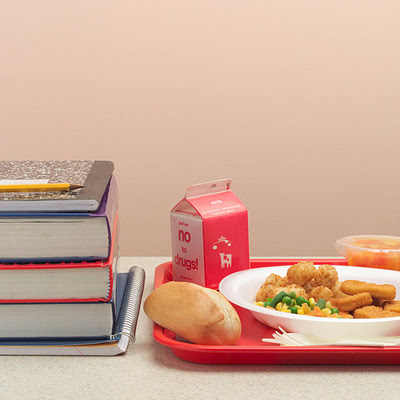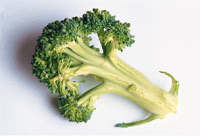School Lunch Gets Healthy

School lunch — for many, the term conjures memories of tater tots, cartons of milk, and fatty, carb-heavy mystery foods that contribute to obesity and poor nutrition. But today, efforts are underway to undo the poor image of school lunches. The noontime bell may signal a period of health, nutrition, plenty of fruit and vegetable servings, and locally-sourced foods. Old-school lunches may be going the way of the abacus.
That’s especially true during National School Lunch Week which is being recognized by school districts throughout the country this week, October 10-14. The week is the culmination of a campaign to promote healthy choices within the school walls, and it coincides with National Farm to School Month, which takes place in October. Farm to School is a K-12 school program that helps make the connection between cafeteria meals and local farms and improves student nutrition as a result. Farm to School programs exist in every state in the nation as grassroots movements that differ depending on the community that creates them. In Maine, the Farm to School program includes projects such as Maine Harvest Lunch, seasonal tastings of Maine-fresh food, ongoing purchasing relationships with farms, and several school garden and greenhouse projects.
In Maine, Farms Lead the Way
Because of the advantages to farmers in the state, organizations like MOFGA have led the way to promote healthier school lunches here in Maine. By incorporating local foods, local farms benefit by developing new relationships that help sustain them. Maine Harvest Lunch week, which takes place in September, has increased participants each year since it began. Schools that participate in the program feature local, healthy foods on their school menus that have been provided by local farmers. The Portland Public School district, for example, has increased the amount of local food incorporated into its school lunch menu with support from the Communities Putting Prevention to Work Obesity Grant. Grant funds have allowed the district to train staff and purchase the equipment necessary to procure and process local produce in season for consumption throughout the school year. They participate by growing food in school gardens that end up in the school salad bar.
Building a Better Tray
Other school-focused nutritional efforts are going on around the state as well. Schools in the Brunswick school district eat local food one day a week every week of the school year — some parents report showing their support that day by giving lunch money to their kids who usually pack their lunch. Recently, a Farmington, Maine farm owned by Andy Marble was profiled in the Morning Sentinel. Marble said his vegetables were sold to area schools that participate in the Farm to School programs, providing a local market that keeps him working. In Kittery, grass-fed beef is now on the cafeteria menu at schools in York and Kittery, according to an article in Seacoast Online, where it is used for the menu’s hamburgers. Michelle Obama’s Let’s Move program has provided grant funds and support for local school programs that combat childhood obesity, including programs that help schools buy foods locally, programs that help them serve grass-fed beef, and programs that ban sodas and junk food from vending machines.

In fact, this year has been good for many school lunch programs in Maine. There have been 39 schools in the state that have applied for the Healthier U.S. Schools Challenge through the federal Department of Agriculture, an honor for elementary schools that recognizes them for things such as offering a different vegetable and fruit every day of the week, and serving whole grains three times a week. Elementary schools in Scarborough, Falmouth, Portland, South Portland, Westbrook, Freeport, Yarmouth, Boothbay, Saco-Old Orchard Beach, and District 61 in Naples applied for the national recognition, showing their interest in being part of leading the way for school nutrition.
Facts About Today’s School Lunch
Want to know more about the face of today’s school lunch? Take a look at some things you may not know about what goes on that cafeteria tray:
- School meals are well-balanced, healthy meals that are required to meet science-based, federal nutrition standards.
- No more than 30% of calories can come from fat in a school lunch, and less than 10% from saturated fat.
- School meals provide 1/3 of Recommended Dietary Allowances of protein, vitamins A and C, iron and calcium.
- Nearly half of school districts offer locally sourced produce, according to the School Nutrition Association.
- Farm to School meals result in consumption of more fruits and vegetables with an average increase of 0.99 to 1.3 servings per day – including at home.
- Schools report a 3-16% percent increase in school meal participation when farm-fresh food is served through Farm to School programs.

Are healthy school lunches sweeping the nation? While efforts at the national, state, and community level are making improvements, all is not always rosy in the cafeteria when it comes to healthy choices. But there are some good things about school lunches that are contributing to big changes for kids and local farms.
Whether you are a school administrator or a parent, there are plenty of resources on the web to help you take part in making even more progress.
Find Out More on the Web:
Tray Talk has facts about school lunches, success stories, and ways to get involved.
The Lunch Box Project is an online toolkit that helps schools with resources for making school lunches nutritious.
Salad Bars to Schools is a grassroots public health effort created to increase the number of salad bars in schools across the country.
Time for Lunch is a part of Slow Food USA that works to help improve school nutrition.
Maine School Garden Network supports educational gardens for kids, and encourages school programs that teach healthy eating and environmental stewardship.
Maine Harvest Lunch promotes featuring local healthy food on school menus while supporting local farmers.
Is your school doing something to improve what kids eat? Share your story!

